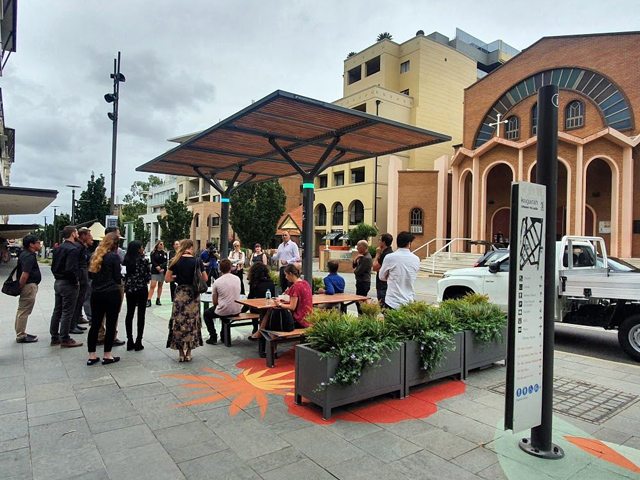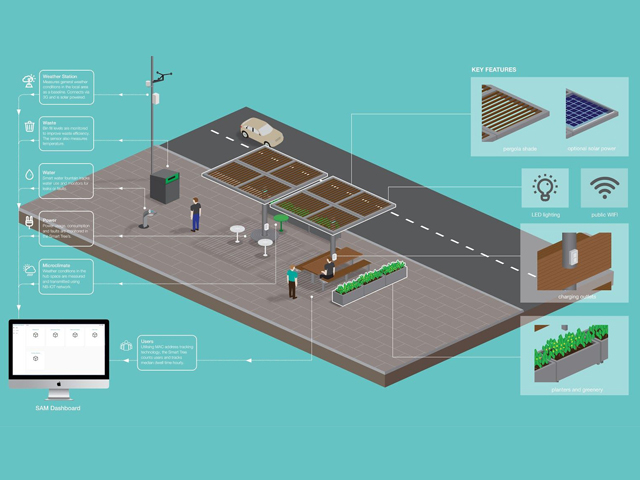SMART CHILLOUT HUB A WORLD FIRST
20 Feb 2020
Street Furniture Australia will today launch the world-first smart ChillOUT Hub, an experimental open-air smart space designed to enhance community connection and amenity in public spaces.

The new experimental open-air smart hubs, created by Australian manufacturer Street Furniture Australia at the company’s studio and factory in Western Sydney, will be officially launched by The Hon. David Coleman (MP) on Thursday 20 February 2020.
Street Furniture Australia Head of Innovation June Lee Boxsell said, “ChillOUT Hubs aim to offer some relief in our constricted cities by providing opportunities to meet, work or rest, and spend more time outdoors.”
“Each hub packs a punch — integrating shade, seats and tables, charging stations, solar power, sensors, lighting, public WiFi, greenery, smart fountains and smart bins — a big feat combining tech, industrial design and placemaking,” she said.
Three hubs are already installed in the Georges River Council region in south Sydney as part of a pilot study for the Australian Government’s Smart Cities and Suburbs Program.
These hubs are the result of collaboration between Council, the Smart Social Spaces research team from UNSW and the University of Sydney, and Street Furniture Australia. 
Street Furniture Australia designed the hubs with input from its partners. Council undertook overall project management, including installation. The Smart Social Spaces team is developing a digital asset management dashboard, and will evaluate the impact of the hubs with a formal study.
University of Sydney Associate Professor Nancy Marshall said her Smart Social Spaces research team was particularly interested in how smart street furniture alters human behaviour in public open space, and how it might contribute to the community’s health and social wellbeing. “We were also curious whether a dashboard could enable councils to more effectively manage their infrastructure,” she said.
“Person-on-the-street surveys are being conducted to give us a complete picture of why the hubs and their technologies are, or are not, being used. We are also analysing how the hubs impact the urban heat microclimate,” Marshall added.
Georges River Council Mayor Kevin Greene said, “As technology becomes more integrated into our lives, it’s important for councils to harness new technologies to better serve the needs of communities and improve services.
“These new public spaces are an exciting achievement as we move towards our goal of creating a connected city.” 
THE DESIGN STORY
Before sketching the hubs, Street Furniture Australia undertook a discovery process to understand user needs and the aspirations of each site.
“We wanted to tailor each ChillOUT Hub to serve its community rather than creating a one-size-fits-all solution. The three sites are very different; spending time in each brought us many insights that are built into each design,” Boxsell said.
“For example, we have an urban streetscape in Kogarah, between the train station, hospital and library, surrounded by offices. There are people constantly passing through. The Kogarah ChillOUT Hub allows you to stop and eat your lunch outside, work using the charging stations, or wait in comfort for a ride.
“We created user personas for all three sites, and designed the hubs around their needs. ChillOUT Hubs became a ‘system’ or a kit of parts for site-specific solutions.” 
THE TECHNOLOGY CONCEPT
From the back end, ChillOUT Hubs are connected to the IoT network to deliver data to councils to assist with decision making, safety and maintenance management.
Sensors are embedded in the hubs to measure three areas: user habits, microclimate and utilities. Data sets include visitation and median dwell time; local UV, humidity and temperature levels; power and water use; and bin fill levels.
A digital dashboard, called SAMS (Smart Asset Management System), will display the information in one interface, and provide alerts for fire and power outage. 
A SMART FUTURE
The increase of high-density living in cities brings greater pressure on public space to provide opportunities to rest, connect with community and immerse in nature. ChillOUT Hubs aim to test a model of how this could be achieved with smart furniture.
“In the context of smart cities, partnerships are vital in delivering successful outcomes. As long as there is a shared goal, a culture of trust and win-win outcomes, we believe collaborations are the way of the future for private industries,” Boxsell said.
“For Georges River Council, the Smart Social Spaces team and Street Furniture Australia, the community was at the heart of this project, so now it’s about listening to them to see how we can bring further amenity and enjoyment to their parks and public spaces. We are here to learn.”
Results of the ChillOUT project will be shared via a White Paper and short film to be released mid-2020.







